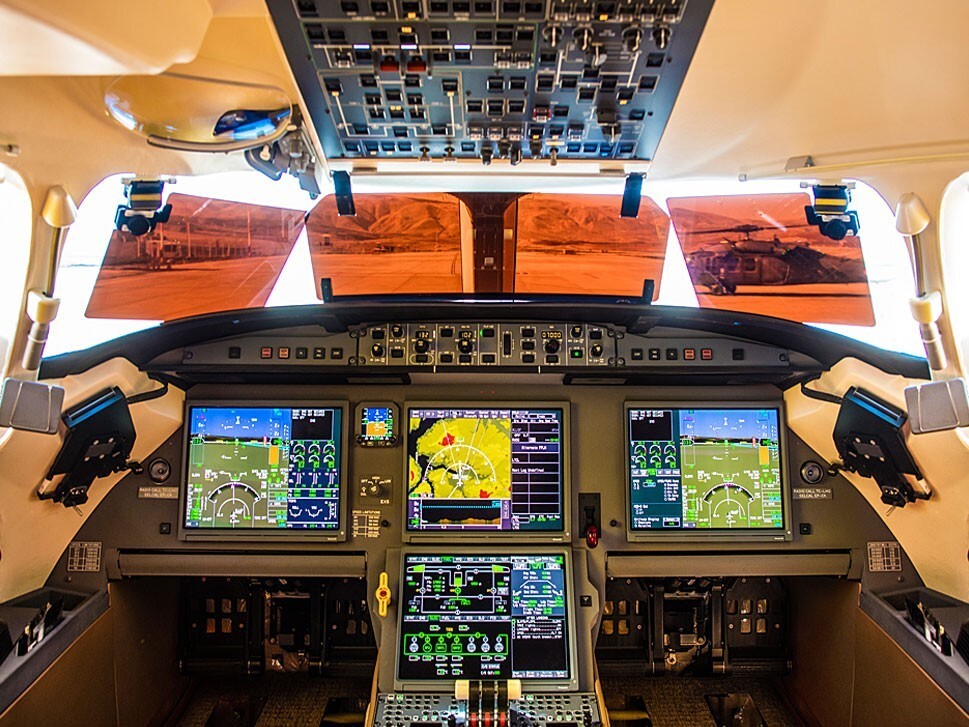- 28 Jul 2022
- Ken Elliott
- Avionics - BizAv
Flight Panel Retrofit: Cost & Value of Equipment
Ken Elliott continues his discussion of the ‘cost’ versus ‘value’ of a flight deck upgrade for business jet operators exploring some of the value considerations relating to the equipment you plan to install…
Back to Articles
Though some equipment installed in a flight panel retrofit may be expensive in terms of cost, the benefits, such as the ‘value’ that equipage brings, will justify the decision to upgrade.
Following, we’ll consider some of the popular areas for retrofit, and the modern equipment being installed in the flight decks of pre-owned aircraft. Some bring tangible payback (in terms of resale price), but all add value in terms of efficiency of operations and enhanced safety in operations.
Did you miss Part 1 of this article Measuring ‘Cost’ versus ‘Value’ of a Flight Panel Retrofit? Read it here on AvBuyer!
Equipment Value Considerations
Anything that can bring benefits to both cabin and cockpit will enhance overall value, a great example being inflight internet. While bringing huge benefits into the cabin, connectivity is also useful to flight crew. Updates such as databases, charts, maps and information transfer, such as aircraft system status and en route flight planning are just some examples of the benefits of cockpit internet.
Sometimes small updates can provide benefits that exceed their cost in value. Installing AC outlets, USB provisions and easy access maintenance port give immediate facilitation to pilots and save on downtime for technicians to connect laptops for system updating and troubleshooting.
Having weather tools from multiple sources is another equipage that has guaranteed benefits of value. Adding SiriusXM weather can be low cost if there is easy access for the antenna installation and while more expensive, upgrading the radar to one with predictive windshear, turbulence and lightning, keeps the pilot in control along risky flightpaths.
Another equipment consideration is to watch the trending of price. A classic example would be Enhanced Vision and especially Enhanced Flight Vision System (EFVS or in Europe, EVS). At one time these were prohibitive to consider or had no factory bulletin or STC as a path to install.
Manufacturers of both aircraft and avionics are rapidly introducing solutions to bring the aircraft closer to the final landing or take-off decision in low-visibility conditions. Recent changes to FAA Airworthiness Circulars (AC) are enabling approaches to touchdown and rollout in low Runway Visual Range (RVR) conditions.
For many, the value of EFVS is hard to quantify, even as options become available and prices head down. However, there is a lot to be said for ‘taking off knowing you can land at the other end, irrespective of visibility’.
There is also the bonus of seeing your aircraft next to a similar brand but having that EVS camera bump on the nose, and the little glass pull down screen in front of the crew. The ‘one-up’ factor, provided by these very visible upgrades of EVS and Head Up Display (HUD), can be a decider during a resale event.
Nothing, however, beats the impact of 3-5 large clean screens across the instrument panel. When showing aircraft, it is very common for non-pilot buyers to be drawn by a slick paint scheme, then dwell in the awesome cabin, followed by a squeeze between the crew seats to have a quick scan at the instrument panel. When the panel is modernized and in keeping with a bespoke interior, the result of the quick scan is satisfying. From that point on the future owner leaves the cockpit details to the experts who wrangle over the contract, but, by and large, the aircraft may be considered sold!
Outfit your aircraft in accordance with your need. If you are planning on short routes or if that is the performance limitation of your model, then install equipment to meet that need. This mostly applies to the cabin and its capability but for the cockpit it may not be necessary to plan on significant airborne connectivity, when you can achieve your communication needs at an FBO between short flight legs.
Integrated flight panels increase pilot ‘out the window’ time, but for short flights the benefit vs cost value may not be there to completely change the panel. Measure this against the risks mentioned in this article, where partial panel upgrades can have support and reliability issues.
Pilot owners are more likely to understand the relationship between flights and equipage needs, where the capabilities and limitations are more intuitive to them. For others, any avionics sales specialist or broker subject matter expert (SME) can advise on this area. Pilot and non-pilot owners may have different value judgements and perspectives, which is partially why you will find all varieties of cockpits across the same model of aircraft.
Getting the maximum use out of an upgrade is another consideration. In an environment where Lateral Path Vertical (LPV) approaches, in the US, now exceed traditional ILS, it begins to make sense to upgrade the aircraft Flight Management System and (possibly Flight Guidance for coupling), to facilitate the many LP/LPV approaches now available.
It is wise to add graphic weather, electronic charts and enhanced maps, when upgrading a flight panel. The options involve a small amount of graft to install and yet a great amount of electronic capability enabled by the manufacturer. It also leads to an uncluttered cockpit, saving space and weight.
If an option means more removal and reinstallation for access, more wiring and significant certification, think twice. If the option is mostly software or a fully compatible ‘slide-in’ component, then the value proposition is good.
Summary...
In an environment where supply is below demand, the dynamics favor the seller. The squeeze is on the few available aircraft to be ready to fly, immediately upon closing the deal.
Any delays from the buyer could cause the seller to unplug the aircraft and move it to one of many alternate buyers.
This situation has an enormous impact on cockpit upgrades, their cost, value and — most importantly — when they should be undertaken. Is it a buyer’s prerogative to upgrade, or should the seller plan to offer an aircraft that is as close to new as possible?
There are arguments either way. For sure, if the aircraft is up to date and ready to fly, for a discerning buyer, the seller may maximize on price, reduce stress for all and expedite the deal. This would seem to be the wisest route to take, if not for the possibility the market mood may shift quickly and there could be an oversupply of pre-owned aircraft.
The price delta between new delivery and pre-owned aircraft is still sufficiently wide enough to allow owners of existing models to repaint exteriors, replace interiors and upgrade cockpits, and still provide significant savings to buyers.
The trick may be in making the updates look, feel and function as close to a new aircraft as possible. That is one large value proposition to consider. Anyone on this track should act fast as new aircraft manufacturers are ramping up both deliveries and new models to sell.
In conclusion, price matters but it depends! Hopefully, this article has provided clues to sellers, buyers, owners and brokers that will enable them to navigate through the cost vs value challenge and come out the other side with an optimum solution for their operation.
Did you miss Part 1 of this article Measuring ‘Cost’ versus ‘Value’ of a Flight Panel Retrofit? Read it here on AvBuyer!
Related Articles
- 30 May 2022
- Ken Elliott
- Avionics - BizAv
- 02 Mar 2022
- Ken Elliott
- Avionics - BizAv


